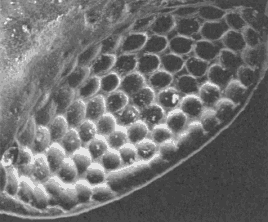Evolutionary Trends in Trilobites – Eyes
I chose to do the evolutionary trends in the highly complex trilobite eye because they have been widely studied and they are the oldest known visual system in the fossil record. Figure 1 shows the life cycle of trilobites, from their rise in the Cambrian called the Cambrian Explosion, to their ensuing decline and finally their extinction in the Permian.
Figure 1 – Graph showing the rise and fall of trilobites. (III, 2007)
Basics
There were 3 types of trilobite eyes. Holochroal, schizochroal and abathochroal. The vast majority of trilobites had holochroal eyes. These eyes had lenses of < 100µm in length and up to 15,000 per eye. The lenses shared a corneal membrane i.e. they had closely packed biconvex lenses underneath a single corneal layer. They were generally hexagonal in shape. Schizochroal eyes, which were found in Phacopids (an order of trilobite found in the lower Ordovician to the Upper Devonian only. They had lenses of 150-750µm in length and up to 100 per eye. Each lense had its own individual corneal membrane. (III, 2007) The abathochroal eye is seen only in a few Cambrian trilobites. Less is known about it compared to the other two types of eyes. It is slightly similar to schizochroal eye. But they do not have the interlensar sclera, a thick cuticular material between the lenses. (Euan Clarkson, n.d.)
See figures 2-4.
Figure 2 – Holochroal eye.
Figure 3 – Schizochroal eye
Figure 4 – Abathochroal eye
All images – (III, 2007)
Schizochroal eye evolution
All early trilobites from the Cambrian had holochroal eyes. Schizochroal eyes are thought to have evolved from these. It happened in a process where ancestral traits are retained by a juvenile organism into adulthood. It is known as paedomorphosis. (III, 2007)
Trilobite eyes, their mode of life and consequent evolution
The differences in the ecology of many trilobites meant that there was a huge variation in the size and shape of their eyes. Early trilobites had cresentic eyes. The trilobites’ mode of life had an impact of what type of eyes it had. Free swimming trilobites had eyes so large that they provided a scope of 360°. (Bell, 2013) Some benthic species that moved along the floor through loose debris or algal growth had their eyes on stalks. Other benthic trilobites had eyes which were reduced or were not there at all. Over time the eyes became smaller and eventually didn’t exist. There was no need for them as they lived on the bottom of the sea floor in deep water. Light was almost non-existent and so eyes were of no use to them. These trilobites were called atheloptic. (Barry D. Webby, 2004)
Bibliography
Barry D. Webby, F. P. M. L. D. a. I. G. P. ed., 2004. The Great Ordovician Biodiversification Event . In: New York Chichester, West Sussex: Columbia Unviersity Press, p. 253.
Bell, M. A., 2013. http://www.palaeontologyonline.com/. [Online]
Available at: http://www.palaeontologyonline.com/articles/2013/fossil-focus-trilobites/
[Accessed 2 March 2014].
Euan Clarkson, R. L.-S. G. H., n.d. arago.elte.hu. [Online]
Available at: https://arago.elte.hu/sites/default/files/TrilobiteEye_ASD.pdf
[Accessed 4 March 2014].
III, S. G., 2007. http://www.trilobites.info/. [Online]
Available at: http://www.trilobites.info/hardtrilorisefall.gif
[Accessed 2 March 2014].
III, S. M. G., 2007. http://www.trilobites.info/. [Online]
Available at: http://www.trilobites.info/eyes.htm
[Accessed 28 February 2014].
III, S. M. G., 2007. http://www.trilobites.info/. [Online]
Available at: http://www.trilobites.info/ordphacopida.htm
[Accessed 28 February 2014].
III, S. M. G., n.d. http://www.trilobites.info/. [Online].




